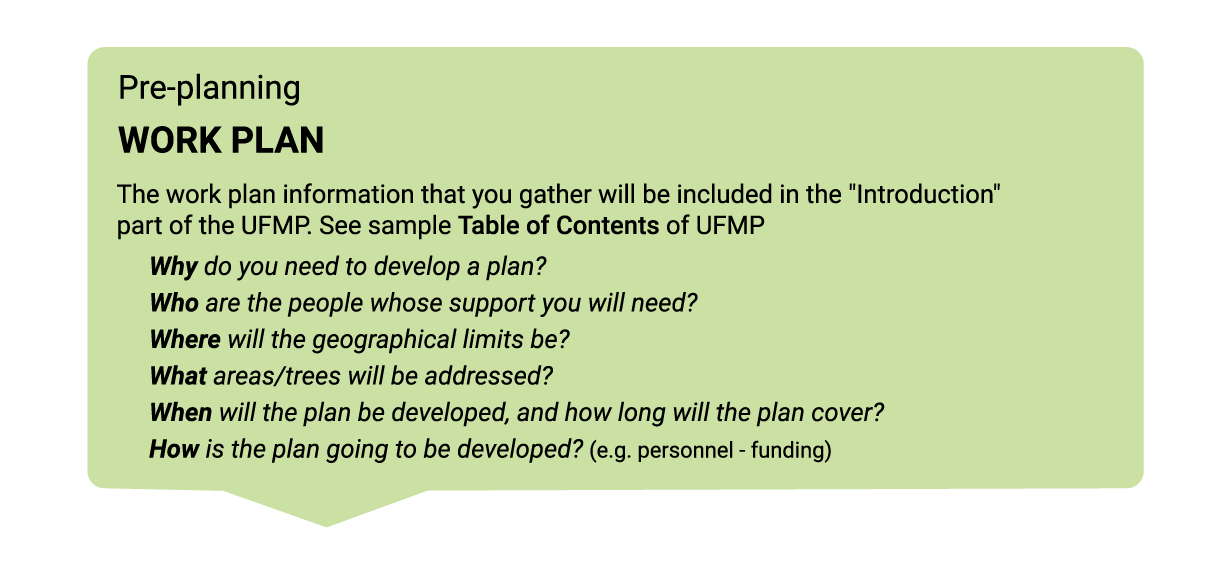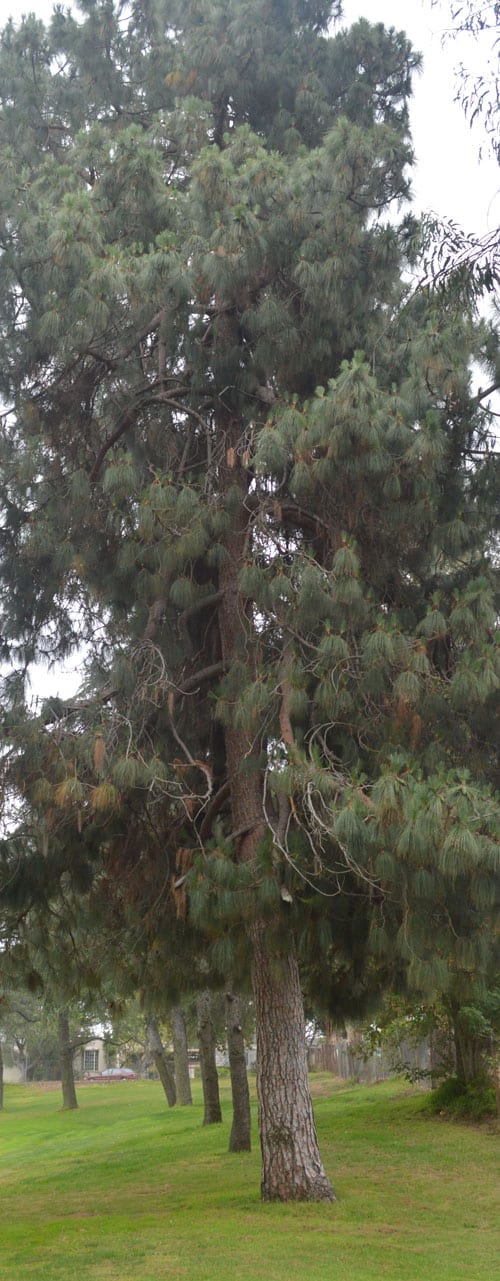Work Plan
Good plans make the difference between cost-effective, proactive management, and costly crisis management.
When developing a work plan, consider available expertise, time, interest, and financial resources. In a work plan, include tools to organize, track, and manage the process of developing the urban forest management plan.
Include:
- a timeline
- a checklist of information to gather
- assigned tasks for gathering and analyzing information

Why?
Why do you need to develop a plan?
The reasons you advance will need to resonate with those who will approve and fund the development and implementation of the plan. Some justifications for the plan might include:
- need to maintain urban forest benefits
- benefit/cost relationships that show the positive contributions of a well-managed urban forest
- need to address community-specific challenges (damage from storms, fires, pest/disease invasions)
- more efficient use of available funding and personnel
- improved ability to compete for future outside grant funding
There might be organizational reasons why it would be especially advantageous to develop or revise a plan at this time. For example:
- grant funding is available
- change in administration or personnel
- a plan is needed to ensure urban forest program continuity in the face of pending retirements.

Who?
Who will be responsible for plan development?
The project coordinator .
Who will help with plan development?
To gather the support and resources necessary to develop and implement an urban forest management plan, you will need to determine the key people and groups in your community who can make it happen. Seek input from a variety of stakeholders to:
- develop a common vision
- assess community values and awareness concerning urban forestry
- review the plan
The impetus for the plan can come from the top down including administrators and elected officials. If from the bottom up, such as requested by citizens or an urban forester, the concept of an urban forest management plan might need to be justified to decision makers or other community stakeholders.
| Sample Task Descriptions | Target Date | Who | |
|---|---|---|---|
| 1 | Authorization and scoping Begin Work Plan development |
||
| 2 | Initial meeting(s) to gather input and assign responsibilities. | ||
| 3 | Develop Vision Statement with input | ||
| 4 | Begin Inventories and Assessments Establish data collection parameters and protocols | ||
| 5 | Data collections | ||
| 6 | Strategic Planning: Data analysis and synthesis | ||
| 7 | Data presentation and initial goal setting meeting/s | ||
| 8 | Develop Goals, Objectives, Actions. | ||
| 9 | Gain approval of the Strategic Plan | ||
| 10 | Implementation Plan: Develop a matrix with who will complete the action and when. | ||
| 11 | Monitoring Plan: establish monitoring protocols, matrix | ||
| 12 | Compile draft plan | ||
| 13 | In-house review of draft plan | ||
| 14 | Public presentation of draft plan | ||
| 15 | Edit draft, compile/format final draft | ||
| 16 | Final plan approval | ||
| 17 | Begin implementation | ||
| 18 | Begin monitoring and Adaptive Management |
Stakeholder analysis is the process of identifying those affected by a project and analyzing their attitudes towards the project and potential changes. Do some brainstorming with others to help identify stakeholders: staff, agencies, groups, businesses, and concerned residents.
Who are the key people and groups that are impacted?
Who are the people and groups whose support you will need?
Who might be good at helping to develop or review the plan?
Which stakeholder groups are likely to influence the success of the plan?
Are these people aware of urban forestry, community concerns, and the specific needs of the area to be planned? If not, how will you educate and engage them?
Where?
Where will the geographical limits be?
What area will the plan cover?
What?
What information is needed?
What portions of the urban forest will be addressed (scope)? Street, park, facility trees, etc.
As you gather support for developing your UFMP, you will need to know what is likely to be approved and funded.
The scope of the plan identifies which trees will be managed. They might include:
- trees planted in urbanized settings (most trees in developed areas)
- retained native trees in urbanized settings
- native trees in relatively undisturbed settings (open space lands)
Will you be planning for trees on private residential, commercial, or urban-agricultural lands? (Trees growing on private lands actually compose the majority of urban forests.)
Are you planning for publicly owned trees, such as street, facility, or park trees?
Are you planning for the entire urban forest: public and privately owned trees within an urban area including trees along streets and in yards, as well as stands of remnant forests?
Does your plan include open space trees in wildland-urban interface, in wildland parks, along waterways, wildlife corridors?
Street trees are one of the most visible portions of the urban forest and have a great impact in terms of shading heat-absorbing surfaces and reducing urban heat island temperatures. Understanding the infrastructure conflicts, conditions, and special management needs of street trees is important for an urban forest management plan.
Facility trees are around buildings and other built facilities. Facility trees play an important role in shading structures and reducing energy use for cooling. Are there unique management or maintenance issues of facility trees that need to be addressed?
Park trees are usually managed by cities, counties, or park districts. Trees in “park–like” settings, such as open areas of campuses, botanical gardens, and other private or public locations will have site-specific needs.
Open space trees, such as in the wildland-urban interface, wildland parks, waterways, and wildlife corridors need to be assessed for native species and invasive, exotic plants and trees, such as Brazilian or Peruvian pepper trees. The needs and management will depend on the composition of the native plant community, what species are present, and land use goals.

| Check those of interest | What will be assessed? | Managed by (specify, e.g. city, residential, commercial, etc.) | Geographic limits (specify, if applicable) | Other (specify) |
|---|---|---|---|---|
| Overall canopy cover | (All) | |||
| Street trees | ||||
| Facility trees | ||||
| Parking lot trees/Shading | ||||
| Park trees | ||||
| Heritage trees | ||||
| Open space trees | ||||
| Other: specify |
When?
Establish a timeline or schedule for developing the plan.
Depending on your level of support, it might be necessary to take an incremental approach rather than going for the most comprehensive plan possible in the first attempt.
What is the timeframe (horizon) that the plan will address? What planning, management and monitoring horizons will be addressed—5, 20, 50 years? Note if different short-term and long-term intervals apply to different plan components.
How?
How is the plan going to be developed?
Personnel: In-house staff or consultants? How will the tasks be shared?
Funding: Consider sources and availability. Vision statements ensure that developers of a plan have a common understanding about the outcome. Vision statements include elements that describe both the urban forest itself and how it is cared for and valued by the people who manage it. For example, if we achieve our goals, how will the area be different than it is now? Or, what do you want the urban forest to look like as a result of the plan?
NOTE: The information you develop in the Work Plan section will help in development of the Introduction to the UFMP.
Work Plan Downloads
16 Comments
Submit a Comment
You must be logged in to post a comment.

very interesting, but nothing sensible
Where is administration?
I’ts important.
Thank.
Where is moderator??
It is about advertisement on your website.
Regards.
Can I contact Administration?
It is about advertisement on your website.
Regards.
Can I contact admin??
I’ts important.
Regards.
Where is admin?
I’ts important.
Regards.
Where is moderator??
It is important.
Thank.
Where is admin?
It is important.
Regards.
Can I contact Administration?
It is about advertisement on your website.
Thank.
Can I contact Administration?
It is important.
Thank.
Where is moderator??
I’ts important.
Regards.
Can I contact Administration?
It is important.
Regards.
Can I contact Administration?
It is important.
Regards.
Where is moderator??
It is important.
Thank.
Where is administration?
I’ts important.
Regards.
loli child porn
==> eit.tw/04G9JV url.epoch.tw/Z4RGq <==